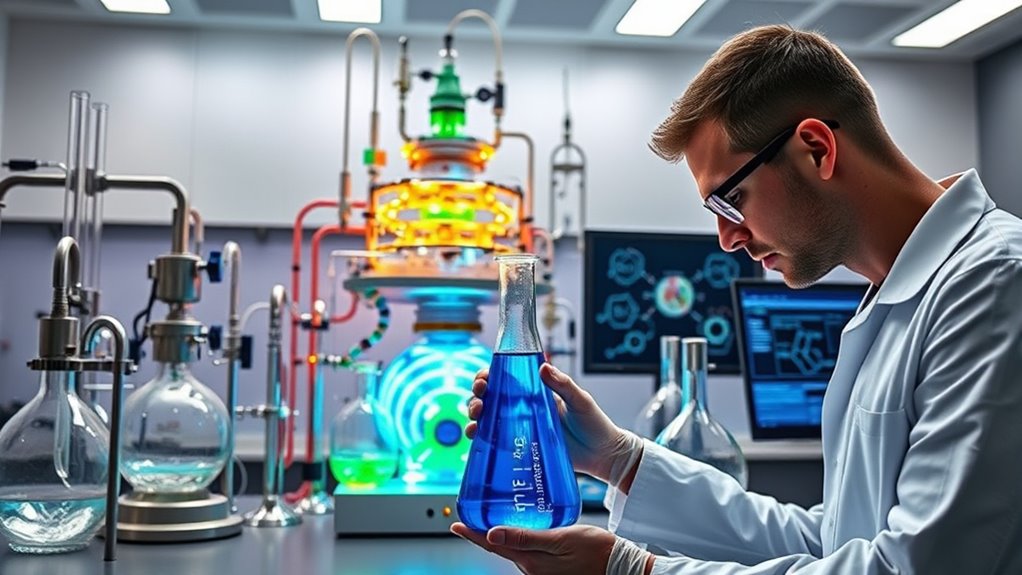Chemists have created a new, highly efficient catalyst that can transform CO₂ into usable fuel, moving us closer to a carbon-neutral future. This breakthrough enhances the speed and effectiveness of converting greenhouse gases, especially when powered by renewable energy sources like solar and wind. Improving catalyst durability and performance supports large-scale, sustainable fuel production. If you want to understand how these advances could reshape energy solutions and reduce emissions, there’s more to discover below.
Key Takeaways
- Chemists have developed a new, highly efficient catalyst to convert CO₂ into usable fuel.
- The process utilizes renewable energy sources, promoting sustainable, carbon-neutral fuel production.
- Catalyst efficiency accelerates conversion rates, making large-scale, practical CO₂-to-fuel methods feasible.
- Advancements in catalyst materials and durability enhance process reliability and economic viability.
- This technology supports reducing greenhouse gases and advancing a sustainable, carbon-neutral future.

Chemists have developed a groundbreaking method to convert carbon dioxide into usable fuel, offering a promising solution to reduce greenhouse gases and combat climate change. This innovative process hinges on the development of a highly efficient catalyst that accelerates the chemical transformation, making the conversion more practical and scalable. The catalyst’s efficiency directly impacts how quickly and effectively CO₂ can be turned into fuel, which is vital for integrating this technology into existing energy systems. You can think of catalyst efficiency as the heart of the process, determining how much fuel you produce per unit of input and how economically viable the technology becomes. The better the catalyst performs, the more seamlessly renewable energy sources can feed into the system, creating a symbiotic relationship that strengthens renewable integration efforts.
Catalyst efficiency is key to transforming CO₂ into fuel and boosting renewable energy integration.
Renewable integration is fundamental in this context because it enables the process to rely on clean energy rather than fossil fuels. When powered by solar, wind, or other renewable sources, this CO₂-to-fuel conversion becomes a truly sustainable cycle. Instead of adding to the greenhouse effect, it helps close the loop by recycling existing carbon dioxide emissions into useful, storable fuels like synthetic gasoline or methanol. This process benefits from ongoing catalyst research, which aims to discover new materials that can operate under practical conditions with higher efficiency. You’re essentially turning excess renewable energy—often available intermittently—into a portable, storable fuel that can be used anytime, day or night. This not only stabilizes the energy supply but also reduces dependence on fossil fuels, pushing us closer to a carbon-neutral future. Moreover, advancements in catalyst durability can significantly enhance the longevity and practicality of this technology.
The key to making this vision a reality lies in optimizing catalyst efficiency, which requires ongoing research into new materials and reaction mechanisms. Scientists are exploring various compounds, nanostructures, and surface modifications to enhance catalytic activity and durability. As these improvements happen, the process becomes faster, more reliable, and cost-effective, boosting the potential for large-scale deployment. Simultaneously, integrating renewable energy into the conversion process guarantees that the entire system remains environmentally friendly. This synergy allows you to imagine a future where excess solar or wind power is directly used to produce fuel, effectively storing renewable energy in a chemical form that’s easy to transport and use.
Ultimately, your role in this evolving landscape is to stay informed about technological advances and support policies that promote renewable integration. As catalysts become more efficient, and as the infrastructure for renewable energy expands, turning CO₂ into fuel will become a viable, mainstream solution for reducing emissions. It’s a promising step toward a sustainable, carbon-neutral future—one where your choices and innovations help reshape our climate’s trajectory.
Frequently Asked Questions
What Are the Environmental Impacts of Large-Scale Co₂ Fuel Production?
You might worry about the environmental footprint of large-scale CO₂ fuel production, but it could help reduce greenhouse gases. However, it also risks ecological disruption if not managed carefully. You should consider that while this process aims to lower carbon emissions, it might cause unintended harm to ecosystems through resource use or waste. Balancing these impacts is vital to guarantee sustainable, eco-friendly fuel solutions.
How Cost-Effective Is the New Catalyst Compared to Existing Solutions?
You’ll find that the new catalyst shows promising economic viability compared to existing solutions, mainly due to lower manufacturing costs. Its efficiency in converting CO₂ into fuel could reduce overall expenses, making it more cost-effective in the long run. Although initial investments might be higher, the potential for scalable production and reduced operational costs could make this catalyst a more affordable option for large-scale fuel production.
Can This Technology Be Integrated Into Current Fuel Infrastructure?
You can consider how this technology might integrate into current fuel infrastructure by examining infrastructure integration challenges and opportunities. It’s essential to evaluate compatibility with existing systems and the policy implications that could support or hinder adoption. If the process aligns with current standards and regulations, scaling up becomes more feasible. Addressing these factors guarantees smoother integration, ultimately advancing sustainable fuel solutions and influencing future energy policies.
What Is the Expected Lifespan and Durability of the Catalyst?
Think of the catalyst as a sturdy bridge; its lifespan depends on how well you maintain it. Catalyst longevity varies with operating conditions, but with proper care, it can last several years. Regular maintenance requirements involve monitoring for degradation signs and occasional replacements. While it’s durable enough for ongoing use, understanding its limits helps you optimize performance and avoid unexpected breakdowns, ensuring your system stays reliable and efficient over time.
Are There Any Safety Concerns With the New Catalytic Process?
You might wonder about safety concerns with the new catalytic process. While the catalyst itself isn’t highly toxic, it’s important to take into account catalyst toxicity and process safety. Proper handling and containment reduce risks, but ongoing monitoring is essential to prevent accidental releases or reactions. Ensuring strict safety protocols minimizes hazards, making the process safer for workers and the environment. Staying informed helps you manage any potential safety issues effectively.
Conclusion
Just as Prometheus brought fire to humanity, these chemists ignite hope by transforming CO₂ into fuel. Their innovation lights the way toward a carbon-neutral future, where we harness nature’s elements rather than depleting them. With every breakthrough, you’re reminded that humans hold the power to rewrite the story of our planet—turning the dark shadows of pollution into a shining dawn of sustainability. The future is yours to shape, fueled by ingenuity and hope.









